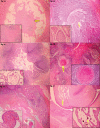Routine histopathologic examination of appendectomy specimens: retrospective analysis of 1255 patients
- PMID: 24229023
- PMCID: PMC3829063
- DOI: 10.9738/INTSURG-D-13-00098.1
Routine histopathologic examination of appendectomy specimens: retrospective analysis of 1255 patients
Abstract
The objective of this study was to analyze the clinical benefit of histopathologic analysis of appendectomy specimens from patients with an initial diagnosis of acute appendicitis. We retrospectively analyzed the demographic and histopathologic data of 1255 patients (712 males, 543 females; age range, 17-85 years) who underwent appendectomy to treat an initial diagnosis of acute appendicitis. Patients who underwent incidental appendectomy during other surgeries were excluded from the study. Histopathologic findings of the appendectomy specimens were used to confirm the initial diagnosis. Ninety-four percent of the appendectomy specimens were positive for appendicitis. Of those, 880 were phlegmonous appendicitis, 148 were gangrenous appendicitis with perforation, and the remaining 88 showed unusual histopathologic findings. In the 88 specimens with unusual pathology, fibrous obliteration was observed in 57 specimens, carcinoid tumor in 11, Encheliophis vermicularis parasite infection in 8, granulatomous inflammation in 6, appendiceal endometriosis in 2, and 1 specimen each showed mucocele, eosinophilic infiltration, Taenia saginata parasite infection, and appendicular diverticulitis. All carcinoid tumors were located in the distal appendix. Six of the 11 carcinoid tumors were defined by histopathology as involving tubular cells, and the other 5 as involving enterochromaffin cells. Six patients had muscularis propria invasion, 2 patients had submucosa invasion, 2 patients had mesoappendix invasion, and 1 patient had serosal invasion. All patients with tumors remained disease free during the follow-up (range, 1-27 months). We conclude that when the ratio of unusual pathologic findings for appendectomy specimens is considered, it is evident that all surgical specimens should be subjected to careful histologic examination.
Figures

References
-
- Zdichavsky M, Gögele H, Blank G, Kraulich M, Meile T, von Feilitzsch M. Histological characterization of appendectomy specimens with intraoperative appearance of vascular injection. Surg Endosc. 2013;27(3):849–853. - PubMed
-
- Chandrasegaram MD, Rothwell LA, An EI, Miller RJ. Pathologies of the appendix: a 10-year review of 4670 appendicectomy specimens. ANZ J Surg. 2012;82(11):844–847. - PubMed
-
- Marudanayagam R, Williams GT, Rees BI. Review of the pathological results of 2660 appendicectomy specimens. J Gastroenterol. 2006;41(8):745–749. - PubMed
-
- Swank HA, Eshuis EJ, Ubbink DT, Bemelman WA. Is routine histopathological examination of appendectomy specimens useful? A systematic review of the literature. Colorectal Dis. 2011;13(11):1214–1221. - PubMed
MeSH terms
LinkOut - more resources
Full Text Sources
Other Literature Sources
Medical

